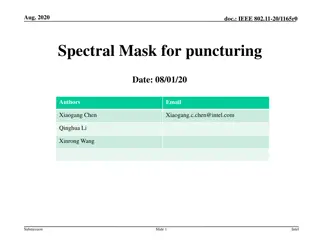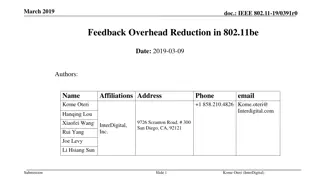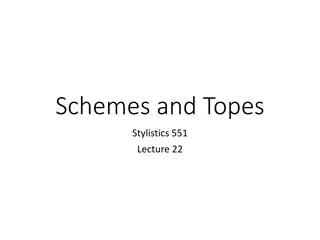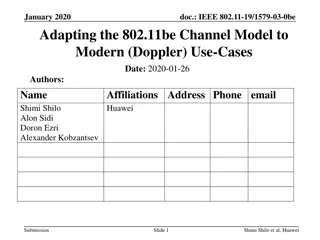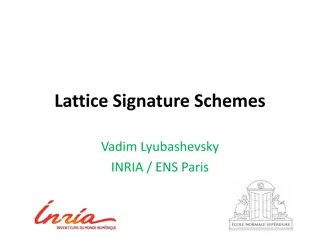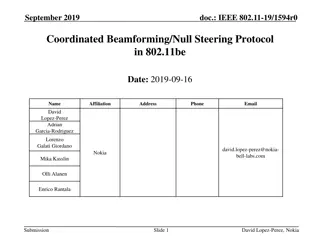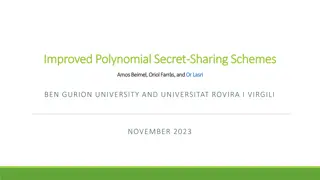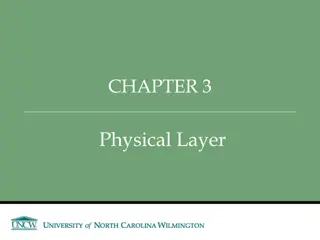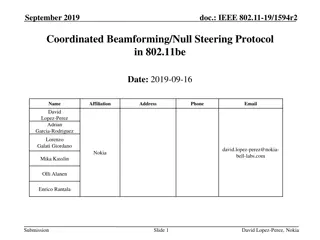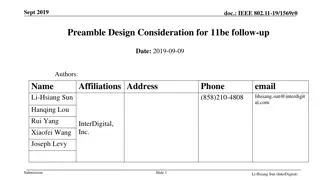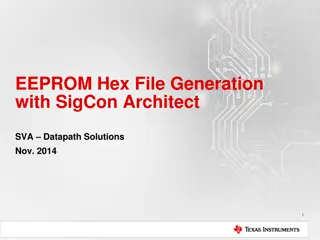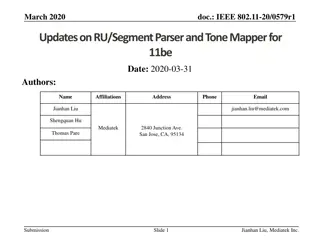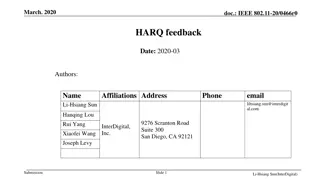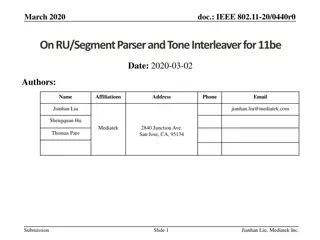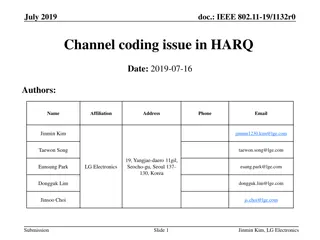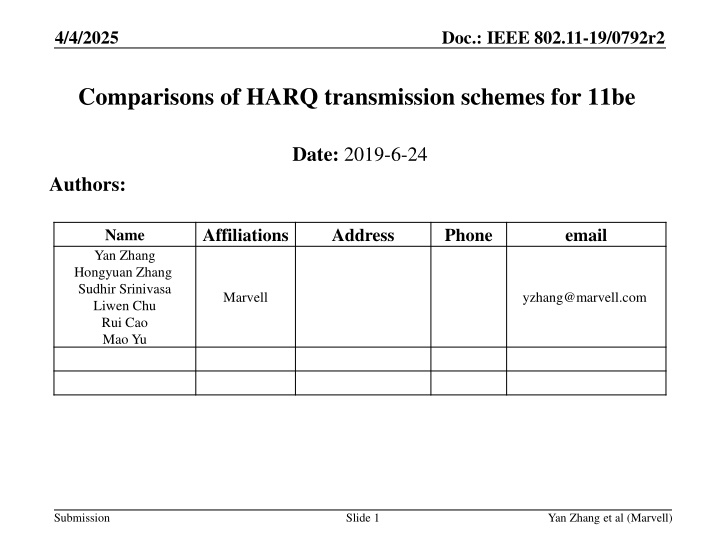
Comparisons of HARQ Transmission Schemes for 802.11be Standard
Explore the comparisons of HARQ transmission schemes for the IEEE 802.11be standard, focusing on HARQ CC, HARQ IR, and Punctured CC. The study evaluates performance gains, frequency diversity, LDPC encoding, throughput improvements, and code rate designs for LDPC encoding in WiFi standards. The simulation setup includes various channel configurations and packet retransmissions to analyze ARQ and different HARQ schemes for enhanced wireless communication efficiency.
Download Presentation

Please find below an Image/Link to download the presentation.
The content on the website is provided AS IS for your information and personal use only. It may not be sold, licensed, or shared on other websites without obtaining consent from the author. If you encounter any issues during the download, it is possible that the publisher has removed the file from their server.
You are allowed to download the files provided on this website for personal or commercial use, subject to the condition that they are used lawfully. All files are the property of their respective owners.
The content on the website is provided AS IS for your information and personal use only. It may not be sold, licensed, or shared on other websites without obtaining consent from the author.
E N D
Presentation Transcript
4/4/2025 Doc.: IEEE 802.11-19/0792r2 Comparisons of HARQ transmission schemes for 11be Date: 2019-6-24 Authors: Affiliations Address Phone email Name Yan Zhang Hongyuan Zhang Sudhir Srinivasa Liwen Chu Rui Cao Mao Yu Marvell yzhang@marvell.com Submission Slide 1 Yan Zhang et al (Marvell)
4/4/2025 Doc.: IEEE 802.11-19/0792r2 HARQ Review HARQ CC is studied in [1][2][3], and show some performance gain over ARQ. To realize the gain, frequency diversity across transmissions is needed to achieve the potential gain via BCC interleaver or LDPC tone mapper patterns varying across transmissions. HARQ IR is shown to have larger performance gain over ARQ in [4][5]. However, this is done with BCC encoding, which is only applied to RU size less than or equal to 242 tones, and MCS up to 9. Hence the gain cannot be realized for the most use cases which utilize larger RU sizes and LDPC encoding. A modified HARQ CC scheme and HARQ IR scheme for LDPC encoding are explored and evaluated along with ARQ and HARQ CC. Submission Slide 2 Yan Zhang et al (Marvell)
4/4/2025 Doc.: IEEE 802.11-19/0792r2 HARQ Punctured CC outline HARQ Punctured CC is improved upon regular HARQ CC to achieve higher throughput without adding much implementation complexities at both transmitter and receiver. All coded bits corresponding to an MPDU are transmitted in the first transmission as in regular HARQ CC. A portion of the coded bits are transmitted in the subsequent retransmissions for soft combining at receiver side. The percentage of the coded bits transmitted in the subsequent retransmissions can be determined based on the first transmission PER statistics. Submission Slide 3 Yan Zhang et al (Marvell)
4/4/2025 Doc.: IEEE 802.11-19/0792r2 HARQ IR outline The HARQ IR for LDPC encoding scheme can support all LDPC code rates and all codeword lengths employed in current WIFI standards. Rate code designs still use the ones in current standard specs. All code rates higher than will be achieved by puncturing rate code for a given LDPC codeword length. All information bits and some parity bits are transmitted in the first transmission for the initial code rate. Additional parity bits are transmitted in the subsequent retransmissions to achieve a lower effective code rate if the initial code rate is higher than 1/2.The lower effective code rates for the subsequent retransmissions can be determined based on either CQI reports or relevant PER statistics. For MCS values with rate code, use the same retransmission schemes as HARQ Punctured CC. Submission Slide 4 Yan Zhang et al (Marvell)
4/4/2025 Doc.: IEEE 802.11-19/0792r2 Simulation setup 20MHz 2x2 (2SS) and 80MHz 4x2 (2SS) DNLOS channel (channels are not normalized) without impairments SU BF, LDPC encoder 4x HE-LTF, MCS0-11 1000 packets Up to 3 (re)transmissions for each packet (2000 bytes) for 20MHz, 2x2 (2SS) channel, and up to 2 (re)transmissions for each packet (8000 bytes) for 80MHz, 4x2 (2SS) channel, same channel realization is applied across all (re)transmissions for each packet. ARQ, HARQ CC, Punctured CC and IR are evaluated (excluding preambles) with both MPDU based retransmissions and codeword based retransmissions. Submission Slide 5 Yan Zhang et al (Marvell)
4/4/2025 Doc.: IEEE 802.11-19/0792r2 HARQ vs ARQ Goodput Comparison, 20MHz 2x2 channel, 2SS, with Optimal MCS selection ARQ vs HARQ Goodput comparision, MPDU based retransmission ARQ vs HARQ goodput comparision,codeword based retransmission 14 14 ARQ HARQ CC HARQ Punctured CC HARQ IR ARQ HARQ CC HARQ Punctured CC HARQ IR 12 12 10 10 Spectral Efficiency (bps/Hz) Spectral Efficiency (bps/Hz) 8 8 6 6 4 4 2 2 0 0 5 10 15 20 25 30 35 40 45 5 10 15 20 25 30 35 40 45 SNR (dB) SNR (dB) For both MPDU based and codeword based retransmission schemes, HARQ Punctured CC and HARQ IR have a few dB gain over HARQ CC and ARQ even with optimal MCS selection. The median gain of HARQ schemes over ARQ are shown below. Median gain(dB) MPDU based Codeword based CC 1.38 1.41 Punctured CC 2.58 2.47 IR 2.90 2.94 Table 1 Median SNR gain of HARQ schemes over ARQ with optimal MCS selection Submission Slide 6 Yan Zhang et al (Marvell)
4/4/2025 Doc.: IEEE 802.11-19/0792r2 ARQ first transmission PER performance, 20MHz 2x2 channel, 2SS 0 SU BF 2x2, 2SS ARQ PER performance 10 -1 10 MCS0 MCS1 MCS2 MCS3 MCS4 MCS5 MCS6 MCS7 MCS8 MCS9 MCS10 MCS11 Per -2 10 -3 10 5 10 15 20 25 30 35 40 45 SNR (dB) First transmission PER varies from 10% to 40% within 2-3 dB range for all MCS levels. Hence MCS selection based on SNR measurements may result in PER varying from 10% to 40%. The MCS levels with the largest SNR ranges are shown below Required SNR 10% PER 20% PER 30% PER 40% PER SNR range MCS 7 31.98dB 30.65dB 29.79dB 29.17dB 2.81dB MCS 9 36.63dB 35.35dB 34.54dB 33.88dB 2.75dB MCS 11 41.61dB 40.31dB 39.52dB 38.87dB 2.74dB Table 2 Required SNR values to achieve packet first transmission PER 10%-40% Submission Slide 7 Yan Zhang et al (Marvell)
4/4/2025 Doc.: IEEE 802.11-19/0792r2 HARQ vs ARQ Goodput Comparison, with first Tx PER varying 10-40%, MPDU based retransmission MCS selection with first Tx PER around0.1 MCS selection with first Tx PER around0.2 15 12 ARQ with rate adaptation HARQ CC HARQ Punctured CC HARQ IR ARQ with rate adaptation HARQ CC HARQ Punctured CC HARQ IR Spectral Efficiency (bps/Hz) Spectral Efficiency (bps/Hz) 10 10 8 6 5 4 2 0 0 10 15 20 25 30 35 40 10 15 20 25 30 35 40 SNR (dB) SNR (dB) MCS selection with first Tx PER around0.3 MCS selection with first Tx PER around0.4 12 12 ARQ with rate adaptation HARQ CC HARQ Punctured CC HARQ IR Spectral Efficiency (bps/Hz) Spectral Efficiency (bps/Hz) ARQ with rate adaptation HARQ CC HARQ Punctured CC HARQ IR 10 10 8 8 6 6 4 4 2 2 0 0 10 15 20 25 30 35 40 10 15 20 25 30 35 SNR (dB) SNR (dB) HARQ Punctured CC and HARQ IR have comparable performances when first Tx PER varies from 10% to 40%. They provides larger throughput gain over ARQ than HARQ CC. The median throughput gains of HARQ schemes over ARQ with rate adaptation are shown in the table 3. Submission Slide 8 Yan Zhang et al (Marvell)
4/4/2025 Doc.: IEEE 802.11-19/0792r2 HARQ vs ARQ Goodput Comparison, with first Tx PER varying 10-40%, Codeword based retransmission MCS selection with first Tx PER around0.1 MCS selection with first Tx PER around0.2 15 15 ARQ with rate adaptation HARQ CC HARQ Punctured CC HARQ IR ARQ with rate adaptation HARQ CC HARQ Punctured CC HARQ IR Spectral Efficiency (bps/Hz) Spectral Efficiency (bps/Hz) 10 10 5 5 0 0 10 15 20 25 30 35 40 10 15 20 25 30 35 40 SNR (dB) SNR (dB) MCS selection with first Tx PER around0.3 MCS selection with first Tx PER around0.4 15 12 ARQ with rate adaptation HARQ CC HARQ Punctured CC HARQ IR ARQ with rate adaptation HARQ CC HARQ Punctured CC HARQ IR Spectral Efficiency (bps/Hz) Spectral Efficiency (bps/Hz) 10 10 8 6 5 4 2 0 0 10 15 20 25 30 35 40 10 15 20 25 30 35 SNR (dB) SNR (dB) With codeword based retransmission, goodput of all transmission schemes improved compared to MPDU based retransmission. However, the spectral efficiency gains of HARQ schemes over ARQ with rate adaptation are comparable to that of MPDU based schemes. The median throughput gains of HARQ schemes over ARQ with rate adaptation are shown in the table 4. Submission Slide 9 Yan Zhang et al (Marvell)
4/4/2025 Doc.: IEEE 802.11-19/0792r2 HARQ vs ARQ Goodput Comparison, with first Tx PER varying 10-40% Median SE gain 10% PER 20% PER 30% PER 40% PER CC 11.5% 24.6% 37.0% 49.8% Punctured CC 18.4% 37.9% 57.8% 78.5% IR 18.2% 39.1% 61.3% 85.3% Table 3. Spectral efficiency gain of HARQ schemes over ARQ with rate adaptation with MPDU based retransmission Median SE gain 10% PER 20% PER 30% PER 40% PER CC 9.6% 24.0% 40.7% 59.9% Punctured CC 12.4% 32.0% 53.7% 79.1% IR 13.0% 32.7% 56.6% 84.2% Table 4. Spectral efficiency gain of HARQ schemes over ARQ with rate adaptation with Codeword based retransmission Spectral efficiency gain of HARQ Punctured CC and HARQ IR over ARQ with rate adaptation is significant when first Tx PER is above 20% for both MPDU based and codeword based retransmissions. Submission Slide 10 Yan Zhang et al (Marvell)
4/4/2025 Doc.: IEEE 802.11-19/0792r2 HARQ vs ARQ Goodput Comparison, 80MHz 4x2 channel, 2SS, with Optimal MCS selection ARQ vs HARQ goodput comparision, MDPU based retransmission ARQ vs HARQ goodput comparision, Codeword based retransmission 14 14 ARQ HARQ Punctured CC HARQ IR ARQ HARQ Punctured CC HARQ IR 12 12 10 Spectral efficiency (bps/Hz) 10 spectral efficiency (bps/Hz) 8 8 6 6 4 4 2 2 0 0 5 10 15 20 25 30 35 5 10 15 20 25 30 35 SNR (dB) SNR (dB) For both MPDU based and codeword based retransmission schemes, HARQ Punctured CC and HARQ IR have small gain over ARQ with optimal MCS selection due to large beamforming gain. The median gain of HARQ schemes over ARQ are shown below. Median gain(dB) MPDU based Codeword based Punctured CC 0.80dB 0.72dB IR 0.62dB 0.48dB Table 5 Median SNR gain of HARQ schemes over ARQ with optimal MCS selection Submission Slide 11 Yan Zhang et al (Marvell)
4/4/2025 Doc.: IEEE 802.11-19/0792r2 ARQ first transmission PER performance, 80MHz 4x2 channel, 2SS 100 SU 4x2, 2SS ARQ PER performance 10-1 MCS0 MCS1 MCS2 MCS3 MCS4 MCS5 MCS6 MCS7 MCS8 MCS9 MCS10 MCS11 Per 10-2 10-3 0 5 10 15 20 25 30 35 SNR (dB) Due to large beamforming gain, PER varies from 10% to 40% within 1dB range for all MCS levels. Hence MCS selection based on SNR measurements may result in PER varying from 10% to 40%. SNR ranges for some MCS levels are shown below Required SNR 10% PER 20% PER 30% PER 40% PER SNR range MCS 7 22.87dB 22.52dB 22.17dB 21.88dB 0.99dB MCS 9 27.81dB 27.47dB 27.12dB 26.87dB 0.95dB MCS 11 32.91dB 32.61dB 32.31dB 32.01dB 0.90dB Table 6 Required SNR values to achieve packet first transmission PER 10%-40% Submission Slide 12 Yan Zhang et al (Marvell)
4/4/2025 Doc.: IEEE 802.11-19/0792r2 HARQ vs ARQ Goodput Comparison, with first Tx PER varying 10-40%, MPDU based retransmission MCS selection with first Tx PER around0.1 MCS selection with first Tx PER around0.2 15 15 Spectral Efficiency (bps/Hz) Spectral Efficiency (bps/Hz) ARQ with rate adaptation HARQ Punctured CC HARQ IR ARQ with rate adaptation HARQ Punctured CC HARQ IR 10 10 5 5 0 0 5 10 15 20 25 30 5 10 15 20 25 30 SNR (dB) SNR (dB) MCS selection with first Tx PER around0.3 MCS selection with first Tx PER around0.4 15 15 Spectral Efficiency (bps/Hz) Spectral Efficiency (bps/Hz) ARQ with rate adaptation HARQ Punctured CC HARQ IR ARQ with rate adaptation HARQ Punctured CC HARQ IR 10 10 5 5 0 0 5 10 15 20 25 30 5 10 15 20 25 30 SNR (dB) SNR (dB) HARQ Punctured CC and HARQ IR have comparable performances when first Tx PER varies from 30% to 40%, while the former has some gain over the latter when first Tx PER varies from 10% to 20%. The median throughput gains of HARQ schemes over ARQ with rate adaptation are shown in the table 7. Submission Slide 13 Yan Zhang et al (Marvell)
4/4/2025 Doc.: IEEE 802.11-19/0792r2 HARQ vs ARQ Goodput Comparison, with first Tx PER varying 10-40%, Codeword based retransmission MCS selection with first Tx PER around0.1 MCS selection with first Tx PER around0.2 15 15 Spectral Efficiency (bps/Hz) Spectral Efficiency (bps/Hz) ARQ with rate adaptation HARQ Punctured CC HARQ IR ARQ with rate adaptation HARQ Punctured CC HARQ IR 10 10 5 5 0 0 5 10 15 20 25 30 5 10 15 20 25 30 SNR (dB) SNR (dB) MCS selection with first Tx PER around0.3 MCS selection with first Tx PER around0.4 15 15 Spectral Efficiency (bps/Hz) Spectral Efficiency (bps/Hz) ARQ with rate adaptation HARQ Punctured CC HARQ IR ARQ with rate adaptation HARQ Punctured CC HARQ IR 10 10 5 5 0 0 5 10 15 20 25 30 5 10 15 20 25 30 SNR (dB) SNR (dB) With codeword based retransmission, goodput of all transmission schemes improved compared to MPDU based retransmission. The spectral efficiency gains of HARQ schemes over ARQ with rate adaptation are much smaller that of MPDU based schemes. The median throughput gains of HARQ schemes over ARQ with rate adaptation are shown in the table 8. Submission Slide 14 Yan Zhang et al (Marvell)
4/4/2025 Doc.: IEEE 802.11-19/0792r2 HARQ vs ARQ Goodput Comparison, with first Tx PER varying 10-40% Median SE gain 10% PER 20% PER 30% PER 40% PER Punctured CC 11% 29% 50% 72% IR 7% 25% 47% 70% Table 7. Spectral efficiency gain of HARQ schemes over ARQ with rate adaptation with MPDU based retransmission Median SE gain 10% PER 20% PER 30% PER 40% PER Punctured CC 1.5% 6.5% 17.7% 33.6% IR 0.9% 5.9% 17.4% 34.2% Table 8. Spectral efficiency gain of HARQ schemes over ARQ with rate adaptation with Codeword based retransmission Spectral efficiency gain of HARQ Punctured CC and HARQ IR over ARQ with rate adaptation is significant when first Tx PER is above 20% for MPDU based retransmissions, while it is much smaller for codeword based retransmissions. Submission Slide 15 Yan Zhang et al (Marvell)
4/4/2025 Doc.: IEEE 802.11-19/0792r2 Discussions on HARQ Punctured CC Memory Based on our simulations, buffer memory requirements will significantly reduced after two transmissions for SU BF 2x2, 2SS case, as shown in the Table 9. (SNR operating point corresponds to packet first transmission PER around 40% for each MCS level). PER 1st Transmission 2nd Transmission 3rd Transmission MCS 0 39.8% 31.5% 0.5% MCS 1 40.8% 30.9% 0.4% MCS 3 40.8% 9.8% 0.3% MCS 4 40.1% 11.7% 0.1% MCS 5 39.8% 6.9% 0 MCS 6 40.2% 9.7% 0 MCS 7 40.1% 13.9% 0 MCS 8 39.3% 8.7% 0.1% MCS 9 40.2% 10.7% 0 MCS 10 40.6% 8.3% 0.1 MCS 11 39.7% 9.9% 0 Table 9 PER statistics after each transmission with HARQ Punctured CC scheme for SU BF 2x2, 2SS Submission Slide 16 Yan Zhang et al (Marvell)
4/4/2025 Doc.: IEEE 802.11-19/0792r2 Discussions on HARQ Punctured CC Memory Similarly buffer memory requirements will significantly reduced after two transmissions for SU BF 4x2, 2SS case, as shown in the Table 10. PER 1st Transmission 2nd Transmission MCS 0 40.9% 29.5% MCS 1 39.5% 32.6% MCS 2 39.1% 33% MCS 3 39.9% 15.8% MCS 4 39.7% 14% MCS 5 40.4% 4.6% MCS 6 39.4% 7.4% MCS 7 39.7% 15.4% MCS 8 40% 9% MCS 9 40.2% 2.5% MCS 10 39.4% 1.4% MCS 11 39.7% 1% Table 10 PER statistics after each transmission with HARQ Punctured CC scheme for SU BF 4x2, 2SS Submission Slide 17 Yan Zhang et al (Marvell)
4/4/2025 Doc.: IEEE 802.11-19/0792r2 Discussions on HARQ Punctured CC Memory With codeword based retransmission, buffer size can be further reduced. The following figures show the distribution of number of incorrectly decoded codewords after 1, 2 and 3 transmissions with HARQ Punctured CC when SNR operating points correspond to packet first transmission PER around 40% for SU BF 2x2, 2SS transmission. PDF of number of wrong codewords in different transmissions for MCS0 PDF of number of wrong codewords in different transmissions for MCS1 PDF of number of wrong codewords (%) PDF of number of wrong codewords (%) 25 20 first transmission second transmission third transmission first transmission second transmission third transmission 20 15 15 10 10 5 5 0 0 0 5 number of wrong codewords 10 15 20 0 5 number of wrong codewords 10 15 20 PDF of number of wrong codewords in different transmissions for MCS3 PDF of number of wrong codewords in different transmissions for MCS4 PDF of number of wrong codewords (%) PDF of number of wrong codewords (%) 20 20 first transmission second transmission third transmission first transmission second transmission third transmission 15 15 10 10 5 5 0 0 0 5 number of wrong codewords 10 15 20 0 2 4 6 8 10 12 number of wrong codewords A large percentage of failed first transmission have all codewords incorrectly received, but this is reduced by more than half for MCS 0 and MCS 1, and reduced by more than 85% for MCS 3 and MCS 4. There are very few errors after 3 transmissions. Submission Slide 18 Yan Zhang et al (Marvell)
4/4/2025 Doc.: IEEE 802.11-19/0792r2 PDF of number of wrong codewords (%)PDF of number of wrong codewords in different transmissions for MCS5 PDF of number of wrong codewords (%)PDF of number of wrong codewords in different transmissions for MCS6 20 20 first transmission second transmission third transmission first transmission second transmission third transmission 15 15 10 10 5 5 0 0 0 2 4 number of wrong codewords 6 8 10 12 14 0 2 4 6 8 10 12 number of wrong codewords PDF of number of wrong codewords (%)PDF of number of wrong codewords in different transmissions for MCS7 PDF of number of wrong codewords (%)PDF of number of wrong codewords in different transmissions for MCS8 20 12 first transmission second transmission third transmission first transmission second transmission third transmission 10 15 8 10 6 4 5 2 0 0 0 2 4 6 8 10 12 0 2 4 6 8 10 12 number of wrong codewords number of wrong codewords PDF of number of wrong codewords in different transmissions for MCS9 PDF of number of wrong codewords in different transmissions for MCS10 PDF of number of wrong codewords (%) PDF of number of wrong codewords (%) 15 15 first transmission second transmission third transmission first transmission second transmission third transmission 10 10 5 5 0 0 0 2 4 6 8 10 12 0 2 4 6 8 10 12 number of wrong codewords number of wrong codewords PDF of number of wrong codewords in different transmissions for MCS11 PDF of number of wrong codewords (%) 15 first transmission second transmission third transmission 10 5 0 0 2 4 6 8 10 12 number of wrong codewords A large percentage of failed first transmission have all codewords incorrectly received, but this is reduced by more than 90% for MCS 5-11 after 2 transmissions. There are almost no errors after 3 transmissions except MCS 8 and MCS10 each have one instance of one codeword error. Submission Slide 19 Yan Zhang et al (Marvell)
4/4/2025 Doc.: IEEE 802.11-19/0792r2 Discussions on HARQ Punctured Memory The following figures show the number of incorrectly decoded codewords after 1 and 2 transmissions with HARQ Punctured CC when SNR operating points correspond to packet first transmission PER around 40% for SU BF 4x2, 2SS transmission. PDF of number of wrong codewords(%)PDF of number of wrong codewords in different transmissions for MCS0 PDF of number of wrong codewords(%)PDF of number of wrong codewords in different transmissions for MCS1 14 14 first transmission second transmission first transmission second transmission 12 12 10 10 8 8 6 6 4 4 2 2 0 0 0 10 20 number of wrong codewords 30 40 50 60 70 0 10 20 number of wrong codewords 30 40 50 60 70 PDF of number of wrong codewords(%)PDF of number of wrong codewords in different transmissions for MCS2 PDF of number of wrong codewords(%)PDF of number of wrong codewords in different transmissions for MCS3 10 10 first transmission second transmission first transmission second transmission 8 8 6 6 4 4 2 2 0 0 0 10 20 30 40 50 0 10 20 number of wrong codewords 30 40 50 60 70 number of wrong codewords Number of wrong codewords among most of the packets are greatly reduced to below 8 codewords after 2 transmission with HARQ Punctured CC for MCS0 MCS3. Few packets have all codewords wrong after 2 transmissions. Submission Slide 20 Yan Zhang et al (Marvell)
4/4/2025 Doc.: IEEE 802.11-19/0792r2 PDF of number of wrong codewords(%) PDF of number of wrong codewords(%) PDF of number of wrong codewords in different transmissions for MCS4 PDF of number of wrong codewords in different transmissions for MCS5 12 8 first transmission second transmission first transmission second transmission 10 6 8 6 4 4 2 2 0 0 0 5 10 15 20 25 30 35 40 45 0 10 20 30 40 50 number of wrong codewords number of wrong codewords PDF of number of wrong codewords(%) PDF of number of wrong codewords(%) PDF of number of wrong codewords in different transmissions for MCS6 PDF of number of wrong codewords in different transmissions for MCS7 8 15 first transmission second transmission first transmission second transmission 6 10 4 5 2 0 0 0 10 20 30 40 50 0 5 10 15 20 25 30 35 40 45 number of wrong codewords number of wrong codewords PDF of number of wrong codewords(%) PDF of number of wrong codewords(%) PDF of number of wrong codewords(%) PDF of number of wrong codewords(%) PDF of number of wrong codewords in different transmissions for MCS8 PDF of number of wrong codewords in different transmissions for MCS9 10 10 first transmission second transmission first transmission second transmission 8 8 6 6 4 4 2 2 0 0 0 5 10 15 20 25 30 35 40 45 0 5 10 15 20 25 30 35 40 45 codeword index codeword index PDF of number of wrong codewords in different transmissions for MCS10 PDF of number of wrong codewords in different transmissions for MCS11 15 10 first transmission second transmission first transmission second transmission 8 10 6 4 5 2 0 0 0 10 20 codeword index 30 40 50 0 5 10 15 20 25 30 35 40 45 codeword index Number of wrong codewords of most packets are less than 10 for the first transmission, and the number of wrong codewords for all packets are greatly reduced below 5 for MCS5 and above, and most of the packets only have one wrong codewords. Submission Slide 21 Yan Zhang et al (Marvell)
4/4/2025 Doc.: IEEE 802.11-19/0792r2 Discussions on HARQ Memory If receiver cannot buffer the LLRs for certain MPDUs due to memory limitations, it can signal this information to the transmitter. Once transmitter receives the signaling, it will adjust the subsequent retransmissions accordingly, i.e., retransmit the same coded bits as those sent in the first transmission. Alternatively, transmitter can estimate how many MPDUs receiver can buffer based on receiver buffer capacity exchanged at the HARQ request/response stage. Based on received Block Ack information, transmitter can roughly estimates how many retransmission MPDUs and new MPDUs can be aggregated in the next A-MPDU so that receiver has enough memory to buffer the MPDUs under normal circumstances. In order to prevent the LLR buffer overflow, transmitter should give retransmission MPDUs higher priority, so that the receiver can flush out LLR buffer reserved for the retransmission MPDUs in time. Submission Slide 22 Yan Zhang et al (Marvell)
4/4/2025 Doc.: IEEE 802.11-19/0792r2 Discussion and Conclusions As shown in slides 7 and 12, first transmission PER can varies from 10% to 40% even when SNR operating point only varies within 2dB or smaller when beamforming gain is high. SNR measurements most likely varies around this range compared to the real channel. Hence it is very difficult to achieve optimal ARQ link adaptation, i.e., achieving 10% PER for selected MCS. As shown in slides 9-10, and 13-14, both HARQ Punctured CC and HARQ IR can have significant throughput gain over ARQ with rate adaptation when first transmission PER is above 20%. HARQ regular CC requires BCC interleaver or LDPC tone mapper varying over different transmission to get the frequency diversity gain, while HARQ punctured CC and HARQ IR have no such requirement. The throughput gain from HARQ regular CC is much smaller than the other two schemes, as shown in tables 3 and 4. Although codeword based retransmission scheme can improve throughput for both HARQ and ARQ, and requires less buffer memory, it also requires more PHY and MAC changes. MAC MBA needs to be modified to codeword level, and the number of codewords could be more than thousand for a large data packet. PHY needs add signaling to indicate mapping between codewords and MPDUs Each codeword need extra CRC information to prevent false detection, such as FCS appending at the end of each codeword. Submission Slide 23 Yan Zhang et al (Marvell)
4/4/2025 Doc.: IEEE 802.11-19/0792r2 Conclusions and Proposals HARQ transmission should be adopted in 11be to compensate performance degradation due to inaccurate link adaptation, (e.g., avoid rate drop when PER reaches certain threshold), and reduce the number of retransmissions, thus improving STA throughput and network efficiency. The proposed HARQ Punctured CC requires least changes based on the current PHY design, and provides higher throughput gain than HARQ CC. The proposed HARQ IR requires larger buffer memory than HARQ punctured CC for most of the MCS transmission, and the throughput of two schemes are comparable for all simulated cases. HARQ Punctured CC should be adopted as an mandatory feature for HARQ transmission due to its advantages over other schemes. Submission Slide 24 Yan Zhang et al (Marvell)
4/4/2025 Doc.: IEEE 802.11-19/0792r2 Reference [1] IEEE 802.11-18/1955r0 HARQ for EHT Further Information [2] IEEE 802.11-18/2029r1 HARQ in EHT [3] IEEE 802.11-18/1992r1 HARQ feasibility [4] IEEE 802.11-19/354r0 Consideration on HARQ [5] IEEE 802.11-19/390r0 Effect of Preamble Decoding on HARQ in 802.11be Submission Slide 25 Yan Zhang et al (Marvell)
4/4/2025 Doc.: IEEE 802.11-19/0792r2 Appendix Wrong codewords statistics of each transmission for HARQ IR Codeword based retransmission, SU BF 2x2, 2SS Wrong codewords statistics of each transmission for HARQ IR Codeword based retransmission, SU BF 4x2, 2SS Submission Slide 26 Yan Zhang et al (Marvell)
4/4/2025 Doc.: IEEE 802.11-19/0792r2 Discussions on HARQ IR Memory Based on our simulations, buffer memory requirements will significantly reduced after two transmissions for SU BF 2x2, 2SS case, as shown in the Appendix Table 1. PER 1st Transmission 2nd Transmission 3rd Transmission MCS 0 39.8% 31.5% 0.5% MCS 1 40.8% 30.9% 0.4% MCS 3 40.8% 9.8% 0.3% MCS 4 57.7% 19.2% 0.1% MCS 5 47.5% 0.5% 0.2% MCS 6 59.9% 16.7% 0 MCS 7 73.8% 19.4% 1.4% MCS 8 55.6% 11.4% 0 MCS 9 71.6% 15.6% 1.1% MCS 10 57.8% 14.8% 0 MCS 11 74.3% 16.3% 0.4% Appendix Table 1 PER statistics after each transmission with HARQ IR scheme for SU BF 2x2, 2SS Submission Slide 27 Yan Zhang et al (Marvell)
4/4/2025 Doc.: IEEE 802.11-19/0792r2 Discussions on HARQ IR Memory Based on our simulations, buffer memory requirements will significantly reduced after two transmissions for SU BF 4x2, 2SS case, as shown in the Appendix Table 2. PER 1st Transmission 2nd Transmission MCS 0 40.9% 29.5% MCS 1 39.5% 32.6% MCS 2 68.6% 24.2% MCS 3 39.9% 15.8% MCS 4 80.5% 28.6% MCS 5 61% 0% MCS 6 83.3% 16.8% MCS 7 93.7% 16.8% MCS 8 85.5% 17.1% MCS 9 97.1 15.3% MCS 10 92% 9% MCS 11 98% 13.2% Appendix Table 2 PER statistics after each transmission with HARQ IR scheme for SU BF 4x2, 2SS Submission Slide 28 Yan Zhang et al (Marvell)
4/4/2025 Doc.: IEEE 802.11-19/0792r2 Discussions on HARQ IR Memory PDF of number of wrong codewords in different transmissions for MCS4 PDF of number of wrong codewords (%) PDF of number of wrong codewords (%) PDF of number of wrong codewords (%) PDF of number of wrong codewords (%) PDF of number of wrong codewords in different transmissions for MCS5 25 15 first transmission second transmission third transmission first transmission second transmission third transmission 20 10 15 10 5 5 0 0 0 2 4 6 8 10 12 14 16 18 0 2 4 6 8 10 12 14 16 18 number of wrong codewords number of wrong codewords PDF of number of wrong codewords in different transmissions for MCS6 PDF of number of wrong codewords in different transmissions for MCS7 20 25 first transmission second transmission third transmission first transmission second transmission third transmission 20 15 15 10 10 5 5 0 0 0 2 4 6 8 10 12 14 16 18 0 2 4 6 8 10 12 14 16 18 number of wrong codewords number of wrong codewords PDF of number of wrong codewords (%) PDF of number of wrong codewords (%) PDF of number of wrong codewords (%) PDF of number of wrong codewords (%) PDF of number of wrong codewords in different transmissions for MCS8 PDF of number of wrong codewords in different transmissions for MCS9 15 25 first transmission second transmission third transmission first transmission second transmission third transmission 20 10 15 10 5 5 0 0 0 0 5 10 15 20 5 10 15 20 number of wrong codewords number of wrong codewords PDF of number of wrong codewords in different transmissions for MCS10 PDF of number of wrong codewords in different transmissions for MCS11 20 20 first transmission second transmission third transmission first transmission second transmission third transmission 15 15 10 10 5 5 0 0 0 0 5 10 15 20 5 10 15 20 number of wrong codewords number of wrong codewords A large percentage of failed first transmissions have all codewords incorrectly received, but this is reduced by more than 90% for MCS 4-11 after 2 transmissions. There are very few errors after 3 transmissions. Submission Slide 29 Yan Zhang et al (Marvell)
4/4/2025 Doc.: IEEE 802.11-19/0792r2 Discussions on HARQ IR Memory PDF of number of wrong codewords (%)PDF of number of wrong codewords in different transmissions for MCS4 PDF of number of wrong codewords(%)PDF of number of wrong codewords in different transmissions for MCS5 20 10 first transmission second transmission first transmission second transmission 8 15 6 10 4 5 2 0 0 0 0 10 20 number of wrong codewords 30 40 50 60 70 10 20 number of wrong codewords 30 40 50 60 70 PDF of number of wrong codewords(%)PDF of number of wrong codewords in different transmissions for MCS6 number of wrong codewords in different transmissions for MCS7 PDF of number of wrong codewords(%) 12 12 first transmission second transmission first transmission second transmission 10 10 8 8 6 6 4 4 2 2 0 0 0 0 10 20 number of wrong codewords 30 40 50 60 70 10 20 number of wrong codewords 30 40 50 60 70 PDF of number of wrong codewords (%) PDF of number of wrong codewords(%) PDF of number of wrong codewords in different transmissions for MCS8 PDF of number of wrong codewords in different transmissions for MCS9 15 12 first transmission second transmission first transmission second transmission 10 10 8 6 5 4 2 0 0 0 0 10 20 number of wrong codewords 30 40 50 60 70 10 20 number of wrong codewords 30 40 50 60 70 PDF of number of wrong codewords(%) PDF of number of wrong codewords(%) PDF of number of wrong codewords in different transmissions for MCS10 number of wrong codewords in different transmissions for MCS11 8 12 first transmission second transmission first transmission second transmission 10 6 8 4 6 4 2 2 0 0 0 0 10 20 number of wrong codewords 30 40 50 60 70 10 20 number of wrong codewords 30 40 50 60 70 Number of wrong codewords are greatly reduced to less than 10 after 2 transmissions with HARQ IR for SU BF 4x2, 2SS case. Submission Slide 30 Yan Zhang et al (Marvell)


